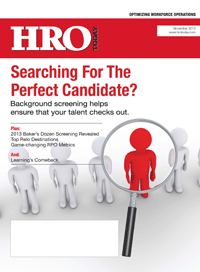
By Russ Banham
Frito-Lay’s respective founders didn’t need to conduct employment background checks when each launched the companies that would eventually merge to become Frito-Lay in 1961. Charles Doolin was Frito’s sole employee when he began selling corn chips from the back of his Model T Ford in 1932. The same year, Herman W. Lay began his potato chip business in much the same fashion.
Fast-forward a few decades and it’s a different story. Frito- Lay, now part of giant PepsiCo, employs 48,000 people worldwide. Hiring employees requires extensive background checks as part of the employment process. In addition to maintaining compliance with employment regulations, the company also seeks to deliver an accurate and swift process for job candidates and its own internal talent acquisition needs.
“We want to present a clear message to job applicants that we are an employer of choice with a strong employeevalue proposition,” says Lauren McEntire, senior manager of organization and management development at Plano, Texas-based Frito-Lay NA, a division of PepsiCo. “Being up- to-date with hiring technology systems and processes, in the context of the candidate experience, is an important part of this goal.”
It is also important to Frito-Lay that job candidates experience a straightforward process when providing information necessary to do a background check. To do this successfully, there are many technology elements at play behind the scenes. By integrating Frito-Lay’s applicant tracking system (ATS) with the background screening technology, the candidate’s perception is one of a “polished, seamless process to share his or her employment information,” McEntire says. “It is important to us that candidates can provide authorizations and disclosures for background screening in a simple, secure way that is also seamless, so they have no concerns about what they’resharing. We put a lot of time and effort to make sure the hiring process is extremely smooth and accurate.”
Frito-Lay’s background screening provider is Atlanta-based First Advantage, which provides a technology solution that integrates with Frito-Lay’s ATS. First Advantage prides itself on its invisibility to job candidates. “We realize we represent the employment brand of our customers,” says Bill Franck, First Advantage executive vice president and client portfolio manager. “Every candidate is a potential employee, and his or her experiences are directly related to their first interactions with the hiring organization. We want these to be positive experiences. We want them to feel they are being treated as human beings. This is the right thing to do and it also is of great value to the employer’s recruitment objectives.”
Such experiences have not always been the case with background screening. Slip-ups were not infrequent in the past, particularly cases where people have common last names like Johnson or Smith. No one wants to be accused of another’s crime or of having presented inaccurate educational criteria.
“A common mistake is a father and son with the same name, albeit missing the Jr. and Sr.,” Franck notes. “The son is right out of college with a stellar future ahead of him, but his father had trouble with the law in past. Meanwhile, their address is the same. If the background screener does not use multiple record identifiers, accuracy can be a problem.”
To minimize the possibility of error, employee screening provider Orange Tree leverages identifiers provided by the applicant or developed through the screening process (like a date of birth, middle names and initials, name suffix, AKAs and current and former addresses). Says Heidi Seaton, vice president of operations and compliance for the Minneapolis- based company, “Our priority is to confirm a potential record really is a match to the applicant before we would report it to an employer.”
Checks and Balances
Organizations mitigate risk through background screening to avoid hiring an employee with a criminal past or a range of fictitious accomplishments. And it’s warranted. According to the ADP Annual Screening Index, 41 percent of employment, education and/or credential reference checks revealed a difference of information between what the applicant provided and what the source reported. Two-thirdsof all job applicants in another study say they have stretched the truth at least once in an effort to land a job. And more than a few job applicants have been able to hide criminal pasts.
“The reality of the industry is that although some employers and schools do store historical verification information by social security number, the majority of county court systems do not,” says Seaton. “A thorough criminal search (is required) to assure that a criminal record really does belong to an applicant before we report that record to an employer.”
Hiring the wrong employee is dangerous and expensive. Workplace violence accounts for 18 percent of all violent crime, according to one study, and, of the 4,547 fatal workplace injuries that occurred in the United States in 2010, 506 were workplace homicides, the Bureau of Labor Statistics reports.
Background screening is a vital part of the employment process, one that, if done well, can result in superior talent acquisition at lower cost. According to the U.S. Small Business Administration, for every dollar an employer invests in employment screening, the return on this investment ranges between $5 and $16, resulting from improved productivity, reduced absenteeism, lower turnover, and decreased employer liability.
With regard to the cost, the U.S. Department of Labor finds that the average employer expense for a bad hiring decision can equal 30 percent of the employee’s first-year income. Nearly 80 percent of worker turnover problems are linked to poor hiring decisions, and the longer that wrong employees stay on the job, the more it will cost to replace them.
These sobering facts explain the vital necessity of assuring the most accurate background checks possible. At the same time, it is equally important that the job candidate not feel like he or she is being unfairly judged or singled out because of an overly burdensome screening process. For employers, this can be a Solomon-like exercise, given the various laws and regulations governing employment practices.
“With the EEOC (Equal Employment Opportunity Commission) and FCRA (Fair Credit Reporting Act) regulations, in addition to similar state rules, we need to ensure for our clients that we’re in complete compliance, so nothing pops up to affect their employment brand,” says Brandon Phillips, president and CEO of Global HR Research,a Fort Myers, Fla.-based employee lifecycle management provider that provides background screening services and ATS solutions.
The firm takes compliance so seriously that it has hired a former Secret Service agent, James Parker, as its director of compliance. “He works with our legal department and chief operating officer to make sure that any changes in state employment laws or federal regulations are carefully and closely monitored,” Phillips says. “We then make fast and thorough adjustments to our system to ensure we are in compliance with the changing regulations, and at the same time inform our clients of these changes.”
McEntire from Frito-Lay says the data analytics she receives on a routine basis from First Advantage assists the company to make more informed decisions. “We are at the mercy of court records, and First Advantage helps us determine what background searches and components are most likely to return the most accurate and comprehensive records. While we want to hire the best quality candidate possible, we also want to give every candidate the opportunity to compete for the job. First Advantage helps us do both.”
Branding Benefits
Employment branding is playing a larger role in the talent acquisition process, and swift and painless background screening can have a positive impact. Organizations strive to portray the reasons why the best and brightest would want to work for them. A hiring experience that is error-prone, overly intrusive, or suggests the employer is technologically unsophisticated will likely steer top-notch talent elsewhere.
“The competition for skills is fierce, making it that much more important that the employer strike the right tone with the candidate by ensuring a smooth and speedy hiring experience,” Franck says. “It also must provide the highest degree of accuracy.”
In this regard, the firm has developed a dispute mechanism whereby it allows candidates at any time to get their full background report. “If we find something derogatory, we notify the candidate in writing what we’ve found. If they feel the information is not accurate, they can call into our dispute center and work towards a resolution,” Franck says.
Accuracy, speed and an efficient, positive candidate experience are the same qualities that gaming company Penn National seeks to provide its job applicants. “My job is to focus on efforts that improve interactions with our job candidates, and simplifying the application process is a huge part of this,” says Tamsin Bencivengo, talent acquisition manager at the Wyomissing, Penn.-based gaming company, comprised of 19 casinos, race tracks and off-track wagering sites across the country.
“The integration between our ATS and our provider’s background screening technology is crucial in these regards,” she explains. “We want everything to be electronic and in one system, and for the candidate to not realize there is a separate background screening vendor [Orange Tree] in the background.”
One of her goals is to limit the amount of candidate effort involved in the hiring process. “By pulling the data the applicant provides to Orange Tree into our ATS, they only input this information once,” she says. “This makes the experience simplified and streamlined and it shortens the time to hire for us. It’s a win-win: It enhances the candidate experience, while positively affecting our bottom line.”
System-to-system integration is important also to Frito-Lay. “We can order a background check from our ATS and view all updates in the ATS,” McEntire says. “It is nice for our front line administrators and hiring managers not to have separate accounts, logins, and people for resets and other issues.”
Franck from First Advantage points out how the process works: “They give us the candidate information and we send emails to the applicants to create their own login, user ID and password. To the candidate, it all looks like Frito-Lay is contacting them for this information directly and is also receiving it.”
Technological sophistication is similarly important to the candidate experience, he adds. “If we are missing certain information, we interact with the candidate electronically, which is the way most job hunters, particularly Millennials, want to interact,” Franck says. “Again, it appears they are interacting solely and exclusively with Frito-Lay.”
Since candidate information is only entered once, there is less chance of error. “The fewer touch points there are, the greater the accuracy and speed, which is important in the `war for talent,’” Franck asserts. “The recruiter and the hiring manager each get the data right away and have a single view of this information.”
New Tweaks
The interplay between employers and providers is improving. First Advantage, for instance, recently added a mobile feature to its background screening platform. “This way, a recruiter at a job fair away from his or her desk can check on the status of people going through the screening process,” Franck says. “If a candidate moves from `in process’ to `approve,’ it’s there for them to see, and thereby immediately extend an offer. It’s just one more way to fill the job post faster.”
Global HR Research offers its clients that lack an ATS access to its own proprietary applicant tracking system, called Jobmatcher. The ATS is linked to the firm’s background screening technology. “We also have a screening solution for volunteers—people who are independent contractors or other types of contingent workers,” Phillips says.
While the providers ease the hiring process, Bencivengo at Penn National points out that at the end of the day, the employer still has to make the decision of whom to hire. “It is great that we are gathering all this information when we need it, but if something is disclosed during the screening process it is our responsibility to dig into it,” she explains. “While Orange Tree has provided hiring guides that assist us through the system that advise us to stop, proceed, or conduct a review, it is our responsibility to still carefully weigh this information to make the appropriate hiring decisions.”
Alas, this part of the employment process cannot be outsourced.

Background screening delivers some very influential information. Consider the following:
- The ADP Annual Screening Index reports 41 percent of employment, education, and/ or credential reference checks revealed a difference of information between what the applicant provided and what the source reported.
- Sixty-six percent of all job applicants say they have stretched the truth at least once in an effort to land a job.
- The U.S. Small Business Administration reports for every dollar an employer invests in employment screening, the return on this investment ranges between $5 and $16.
- The U.S. Department of Labor finds that the average employer expense for a bad hiring decision can equal 30 percent of the employee’s first-year income.
Hiring Right: Get More From Your Background Screening
Components of today’s approaches to screening and hiring candidates are well beyond a mere background check and verification. Today’s process includes:
- Integration with applicant tracking systems
- An elevated candidate experience
- Analytics and reports to zero in on effective metrics
- Employment branding in technology applications
- On-the-go mobile applications
Russ Banham can be reached at www.russbanham.com















